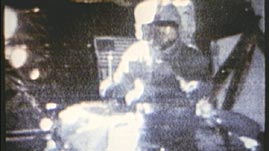Teachers' Domain - Digital Media for the Classroom and Professional Development
User: Preview

Source: NASA
Galileo used thought experiments to test many assumptions, including the notion that heavy objects fall more quickly than lighter objects when they are dropped. Lacking access to either a vacuum chamber or a planetary body that has no atmosphere, he nevertheless correctly predicted that all falling objects would accelerate at the same rate in the absence of air resistance. In this video segment from NASA, astronaut David Scott demonstrates the correctness of Galileo's prediction.
Galileo on the Moon (Audio Description) (Video)
Long before recorded history, humans observed the world around them, taking note of the rise and fall of tides, the phases of the Moon, and countless other physical and astronomical phenomena. Because great thinkers often recorded their observations of such phenomena, we have a historical record of how our understanding of the natural world has changed over time. More than 2,000 years ago, Aristotle concluded that heavier objects fall faster than lighter objects. He also surmised that the rate at which an object falls toward Earth when dropped is directly proportional to its mass, i.e., an object with twice the mass of another falls twice as fast.
We now know that Aristotle was wrong. Although massive objects sometimes fall faster than lighter objects, mass and weight have nothing to do with the rate of their descent. Indeed, if we could control for all variables for any two dropped objects, we would find that they always accelerate toward Earth at exactly the same rate. So, what causes objects to behave differently in so many cases? For example, why do hammers and feathers usually fall at such dramatically different rates?
Air resistance causes feathers, leaves, and other objects we consider lightweight to fall more slowly than more massive objects such as hammers and bowling balls. This force resists the acceleration of falling objects, and the larger an object's surface area, the greater the resistant force. In the absence of air resistance, such as in a vacuum or on the Moon where there is almost no atmosphere, all objects accelerate toward the ground at the same rate.
Gravity, the force that causes objects to fall toward Earth, is also responsible for Earth's atmosphere. Gravity exists between any two objects that have mass. The more massive an object and the closer it is to another object, the greater the gravitational force it exerts on the other object. Earth exerts a gravitational force on gas molecules in the atmosphere, such as water vapor, oxygen, hydrogen, ozone, and carbon dioxide, just as it does on more massive objects, such as the Moon.
The Moon has almost no atmosphere, and because it is one-quarter the diameter of Earth and significantly less dense, the Moon has about one-sixth the gravity of Earth. Thus, the gravitational force the Moon exerts is not strong enough to attract and retain significant quantities of atmospheric gases. In the near absence of these gases, there is no measurable air resistance, and hammers and feathers are free to fall just as Galileo predicted.
To learn more about physical characteristics of the Moon, check out Extreme Temperatures on the Moon, Explore the Moon, and Your Weight on Other Worlds.
To learn more about the Moon's place in the solar system, check out The Origin of the Moon and Why Doesn't the Moon Fall Down?.
To learn more about gravity and weightlessness, check out Free-Falling and "Weightlessness".
 Loading Standards
Loading Standards Teachers' Domain is proud to be a Pathways portal to the National Science Digital Library.
Teachers' Domain is proud to be a Pathways portal to the National Science Digital Library.
